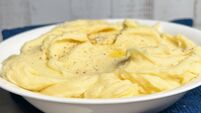Weekend Food with Darina Allen: Robin Gill’s book Larder enraged me and brought me close to tears

The introduction to Robin Gill’s book Larder enraged me and brought me close to tears. Robin’s graphic description of his long and tortuous journey through many kitchens both in Ireland and the UK to become a chef makes harrowing reading and speaks volumes about the reason why there is now a proper chef crisis in so many restaurants.
What Robin, who comes from Malahide in Dublin, and many others have had to endure is not OK, the verbal and physical abuse, sadism and downright cruelty is unconscionable and in any other walk of life would land the perpetrators in jail. How come degrees of this behaviour have been acceptable for so long?
We’re all guilty, we need to ask questions about what’s going on in the kitchen to put the food on our plate. Get a grip, it’s only food after all and it is absolutely not necessary to have a toxic atmosphere to produce delectable morsels on a plate.
In fact, quite the opposite, a happy team oozes energy and creativity; Myrtle Allen herself was a wonderful example to all of us. In all the years I worked in Ballymaloe House kitchen, I never, ever, heard anyone shout or swear, despite all the pressure of a busy kitchen and Myrtle’s unwavering commitment to quality.
It’s a long road that doesn’t have a turn. Robin eventually chanced upon a two-star Michelin, family-run restaurant in Italy with a farm overlooking Capri called Don Alfonso 1890. There he learned the true meaning of “farm to table”.
Robin wrote: “It was my first exposure to true cooking with the seasons, when something was in such abundance and at its best and had to be put to use. It was a revelation to me. Whatever couldn’t be used was preserved and kept for a season less generous. It was natural (and beautiful) in every way.”
He learned how to hold back and let the produce speak for itself. For the first time he truly understood what it means to be seasonal, how to walk the walk, not just talk the talk as sadly so many restaurants do. He spent several years with Raymond Blanc at Le Manoir Aux Quat’ Saisons in Oxford, of which he speaks highly as a teaching kitchen.
In 2013 he and his wife Sarah were ready to open their own place on a prayer and a shoestring in an old building on Clapham Common. It’s called The Dairy, has a herb and vegetable garden in crates on the roof, and is the first of three restaurants Robin and Sarah now own.
Finally back to Robin’s book aptly called Larder published by Absolute Press.
This is an interesting and unusual book , a combination of exquisite but seriously time consuming ‘cheffy’ recipes at the back of the book and a whole amazing section on pickling, preserving, smoking, fermenting, making miso, brewing, infusions and curing recipes at the beginning of the book that make up the basics of his larder.
Many of the recipes are super simple, fun to make and will transform your food as well as get you addicted to stacking your larder shelves.
Robin Gill’s Apricot and Lemon Thyme Jam
Before you begin making the jam, put three or four small plates in the freezer.
Cut the apricots in half and remove the stones, then cut each half into quarters. Place the apricots and water in a large pot and cook over a medium heat for 10 minutes to soften. Stir in the lemon juice and sugar and bring the mixture up to 104C/225F.
Reduce the heat and allow to simmer, stirring now and again, for a further 20 minutes or until the jam has reached soft setting point — use the wrinkle test to check.
To do this, take the pan off the heat and carefully spoon a little jam on to one of the cold plates. Let it stand for a minute, then push the blob of jam with your finger.
If the surface of the jam wrinkles then it has reached setting point; if it is still quite liquid, then put the pan back on the heat and boil the jam for another couple of minutes before testing again, using different plates from the freezer.
Meanwhile, make a brown butter by melting and heating the butter cubes in a pan over a high heat until the butter starts to foam and brown and gives off a nutty aroma. Once this occurs, remove from the heat immediately and cool quickly by setting the base of the pan in cold water, to stop the butter from burning.
Put the honey in another pan and cook over a medium heat to a dark caramel colour. Remove from the heat and stir in the brown butter. Add to the apricot jam while still warm.
Stir through the lemon thyme leaves and salt. Ladle the warm jam into sterilised jars and seal. The jam can be stored in a cool, dark place for up to six months. Once opened, keep in the fridge and use within 6 weeks.
Robin Gill’s Pickled Radishes
Combine the water, vinegar and sugar in a pan and bring to the boil, stirring to dissolve the sugar. Pour this boiling pickling liquor over the radishes in a bowl.
Allow to cool, then decant into sterilised jars and seal. The radishes are ready to use straight away or can be stored in the fridge for up to 2 months.
Robin Gill’s Carrot and Caraway Pickle
Toast the caraway seeds in a dry pan until they smell aromatic. Set aside. Peel the carrots, then slice into thin rounds on a mandolin.
Combine the vinegar, water, sugar and caraway seeds in a suitable-sized pot. Bring to the boil, then add the carrot slices and remove from the heat immediately.
Decant into a sterilised 2-litre jar and seal. The pickle can be stored for 1 year in a cool, dark place. Once opened, keep in the fridge for up to 3 months.
Robin Gill’s Charred Mackerel, Cucumber, Dashi, Sea Purslane
Generally speaking, mackerel must be at its absolute freshest — so when buying your fish, make sure the flesh is firm, the gills are bright red and the eyes are bright and glistening. We use salt to season and firm up the fish, and I like to serve it medium-rare. This is a really fresh and vibrant dish to serve in late summer.
150g picked dill fronds
Peel the cucumbers and set aside; reserve the skin. Blend together the ice, caster sugar, vinegar, dill, the cucumber skin and salt in a blender or food processor.
Strain through a fine sieve and pour this liquid over the peeled cucumbers. Leave to marinate for an hour.
Blend together the dill and oil in a blender or food processor for one minute. Transfer to a pan, bring to the boil and boil rapidly for two minutes.
Strain through a fine sieve into a bowl set over ice to cool. Blowtorch, barbecue or grill (on a hot-ridged grill pan) the skin side of the mackerel fillets. You are just looking to scorch the skin and lightly cook the fish to medium-rare. Season the fillets with lemon juice and salt to taste.
Drain the pickled cucumbers and slice into rounds. Spread a teaspoon of miso purée in each bowl, then add the mackerel.
Top the fish with the cucumber slices (fanned). Place the fresh purslane, sea purslane and wild garlic capers to the side. Drizzle over some dill oil.
In a jug, season the warm dashi with a little of the pickling liquor from the wild garlic capers. The dash should be poured over each dish at the table.
Robyn Gill’s Roast Garlic Miso Purée
Preheat the oven to 180C fan/2ooC/Gas Mark 6. Toss the garlic cloves in the oil and coat them in demerara sugar.
Wrap the cloves loosely in foil to create a parcel. Roast for 25 minutes. Open the parcel and return to the oven to roast for a further 5 minutes. Tip the garlic into a food processor and blend the cloves to a smooth puree.
Put the butter into a pan set over a high heat and cook until the butter starts to foam, brown and take on a nutty aroma. Immediately remove from the heat and cool quickly to stop the butter from burning.
Boil the vinegar in another pan until reduced to 75ml.
Add the brown butter, vinegar, miso and malt extract to the garlic purée and blend until smooth. Cool. The puree can be stored in the fridge in an airtight container for up to 1 month.
Robin Gill’s Dashi
Add the kombu to the water in a pan and bring to a very gentle simmer (do not boil). Simmer for 1 hour.
Strain the liquid through a fine sieve into a jug. Season with the nori, bonito flakes, soy sauce, wild garlic leaves and a pinch of salt. Allow infusing for 5 minutes.
Taste to check the seasoning and adjust as required: the dashi should be salty and savoury with umami.
Strain the dashi through the fine sieve. Once cooled, it can be stored in a sealed container in the fridge for 2-3 days.









